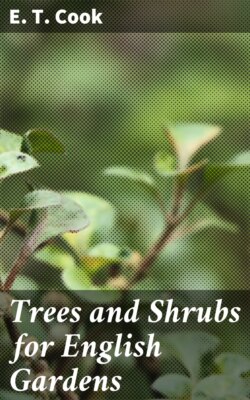Читать книгу Trees and Shrubs for English Gardens - E. T. Cook - Страница 10
На сайте Литреса книга снята с продажи.
HEATHY PATHS IN OUTER GARDEN SPACES
ОглавлениеTable of Contents
The subject of heathy paths comes within the scope of this book. We are not thinking of grass or gravel paths, but those in pleasure-grounds that are beyond the province of the trimly-kept garden, and yet have to be somewhat tamed from the mere narrow track such as serves for the gamekeeper on his rounds. Paths of this kind admit of varied treatment. The nature of the place and the requirements of those who use the paths will determine their general nature, and settle whether they are to be of turf or of something that must be dry in all weathers. But grass and gravel are not the only alternatives. One kind of path not often seen, but always pleasant, and at one time of year distinctly beautiful, can be made of the Common Heather (Calluna vulgaris). We know of such a path, 12 feet wide and some hundreds of feet long, carpeted with this native Heath, mown once a year, and feeling like a thick pile carpet to the feet; grey-green in summer, bronze-coloured in late autumn, and in the second and third weeks of August thickly set with short sprays of the low-toned pink of the Heather bloom. It is not so dry as a gravel path, but a good deal drier than grass, and has a pleasant feeling of elasticity that is absent in common turf.
Many are the pleasure-grounds in the south of England and Scotland where the soil is sandy and, perhaps, peaty. Any such can have these pleasant heathy paths. We have even seen them on a poor sandy clay, scarcely good enough to call loam, in Sussex; for Calluna, unlike the other Heaths, will grow willingly in clay. In the case quoted the plant was wild in the place.
In a Fir wood, the bare earth carpeted with needles always makes a suitable path, and one that is always dry; the only thing to correct is to fill up any places where the bare roots rise above the path level. For in these informal paths, where we want to look about and at the trees, there should be no danger of being tripped up. The path, of whatever nature, should be wide enough for two persons—5 feet to 6 feet is ample; but it should have quite a different character from the garden path, in that its edges are not defined or straightened.
SHRUB AND IRIS GROUPS BY WOODLAND.
One may often see in the outskirts of an old garden a dense wood that once was only a growth of shrubbery size. The walk was originally bordered by a Box edging, and there may have been a strip of flowers between it and the shrubs. Here and there one may still see a yard or two of straggling Box nearly 2 feet high. Of course, this edging should have been removed as soon as the place became a wood, for after a certain time its original use as a formal edging to a trim plantation ceased to exist.
Nothing is pleasanter in woodland than broad, grassy ways, well enough levelled to insure safety to an unheeding walker. In early spring, before the grass has grown any height, here is the place where Daffodils can best be seen and enjoyed, some in the clear grass and some running back in wide drifts into any side opening of the wood. If the grass is cut in June, when the Daffodil foliage is ripe, and again early in September, these two mowings will suffice for the year.
AZALEA GARDEN AT KEW (early Summer).
In many woody places where shade is fairly thick, if there is any grass it will probably be full of moss. No path-carpet is more beautiful than a mossy one; indeed, where grass walks from the garden pass into woodland, the mossy character so sympathetic to the wood should be treasured, and the moss should not be scratched out with iron rakes. Often in the lawn proper a mixture of moss and grass is desirable, though one has been taught that all moss is hateful. In such places, though it may be well to check it by raking out every four or five years, it should by no means be destroyed, for in the lawn spaces adjoining trees or woodland the moss is right and harmonious.
There are paths for the garden and paths for the wood. A mistaken zeal that would insist on the trimness of the straight-edged garden walk in woodland or wild is just as much misplaced as if by slothful oversight an accumulation of dead leaves or other débris of natural decay were permitted to remain in the region of formal terrace or parterre.
Heath paths should be made by either planting or sowing. The common ling (Calluna vulgaris) makes the best turf. If the ground is sown it should be of nearly pure sandy peat, or weeds would be troublesome. If the path is to be made by planting, it should be done with two-year-old seedlings—nothing larger—planted about 6 inches apart. The path when grown should be mown with a machine once a year, in autumn after the blooming time of the heath. There must be no grass.
